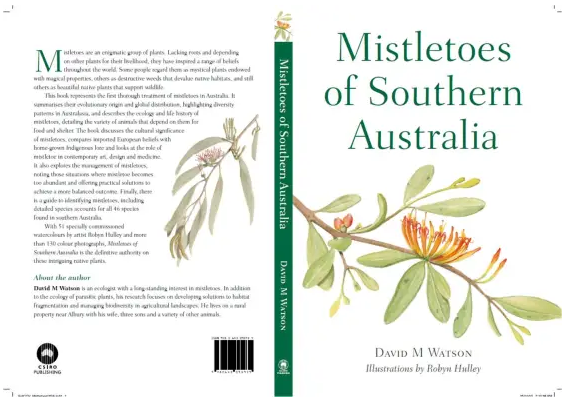Deeper Read – Mistletoe
Introduction
Mistletoe is an important natural component of the Australian environment, providing habitat for many native birds, mammals and insects. Changes in our rural landscapes from clearing, grazing and altered fire patterns have brought about increases in mistletoe numbers, indicating environmental imbalances. While excessive mistletoe numbers may harm host plants, some mistletoe is desirable due to its role in the natural environment.
Mistletoe as Habitat
Mistletoe is particularly valuable habitat. Mistletoe is a rich nectar source, often at times when other nectar is scarce, during summer. Mistletoe nectar is valuable food for many native birds such as honeyeaters, and insects, possums and gliders. Mistletoe fruit is a vital part of the diet of the Mistletoebird and various honeyeaters. Its foliage is good cover for native birds for perching and nesting. Possums, and many butterfly species feed on the foliage.
Mistletoe clumps also provide special microclimates in the tree canopy due to the dense foliage and semi-succulent leaves which constantly transpire. This influences the humidity and helps cool of mistletoe clump which many animals will seek out for nesting and raising their young in during hot weather.
Effects of Mistletoe on Hosts
Mistletoe should only be considered problematic if in excessive numbers, such as over half the canopy of its host plant. Otherwise, consider it a valuable part of the local natural environment. If in excessive numbers, mistletoe may harm hosts by using water freely (contributing to drought stress); by using host mineral nutrients, and by reducing the hosts foliage, hence slowing its growth rate.
Mistletoe Management
Mistletoe can be viewed as an ‘indicator plant’ for environmental health. If present in excessive numbers, it indicates an imbalanced environment in need of remedial action. Short term actions such as removing mistletoe are not productive unless combined with long term measures to improve the local environment.
Long-term Actions
- Fence livestock out from clumps of host trees to encourage regeneration, and reduce other pressures such as soil compaction and raised soil fertility from stock camps.
- Plant locally native understorey plants if they do not regenerate naturally. Understorey plants are essential habitat for mistletoe predators, including butterflies.
Short-term Actions
Remove mistletoe by:
- Cutting it off (remove entire plants to avoid re-sprouting);
- Burning it (mistletoe is fire sensitive, while eucalypt hosts regenerate from fire);
- Pollarding host trees (‘be-head’ trees);
- Spraying it (mistletoe is herbicide sensitive).
Conclusion
Mistletoe should be viewed as an indicator plant when in excessive numbers, signaling a need to restore the local environment. Fencing remnants and restoring the understorey are vital steps in bringing mistletoe back into balance, and keeping our remaining native vegetation healthy.
Find out more…
Mistletoes of Southern Australia – Mistletoe management
Watson, D. 2019. Mistletoes of Southern Australia. CSIRO Publishing


